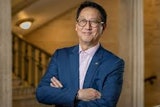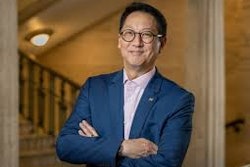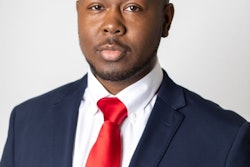Professor Chuck Stone, an awarding winning journalist, earns new honors these days in an arena where few minorities perform. On the faculty of the University of North Carolina, he is among the scant number of professionals who have jettisoned themselves out of the bustling newsroom to pursue new dreams — teaching the next generation of journalists.
Once a rarity in the newsroom, he shattered the obstacles and his well-earned legacy now assures that he’s no classroom novelty. As a distinguished endowed chair professor, his new profession is more than a retirement nest. Thoroughly prepared to meet the new challenges and fully intent on building a new legacy, Stone wants to champion the drive for diversity in college journalism programs.
During the annual convention of the Association for Education in journalism and Mass Communication in August, he told attendees: “Together, I hope that we can find a way to teach and implement diversity in journalism education and make the world a happier expression of God’s multiculturalism.” He also encourages students to pursue journalism by simply telling them “journalism is one of the most honored professions.” That line has been the right buzz words a few times. He has convinced a few students to make the switch.
This task, Stone contends, is vital if talented minds are to be ushered into the Fourth Estate. “We have to compete against other areas for the brightest Black students,” he says. “We need to make them realize there are opportunities. I’ve had three, four students switch over. I tell them that the founding of America goes back to journalism.”
Perhaps his most significant message is, I also tell them don’t take courses. Take teachers. Find out who are the best teachers and take them.” As a professor, his mission is to “show students how to think critically and develop writing skills they can use, even if they don’t become a journalist.”
Winds of Change
“Winds of Change: Whither journalism Education?”, a recent report by the well-respected Freedom Forum, warned that “faculty expertise has diminished increasingly by the hiring of people with no or limited experience as journalists.” According to the report, 17 percent of journalism educators have never worked as fulltime journalists. An additional 47 percent have less than 10 years experience as journalists.
The trend toward less experience is apparent. The doctoral degree is now much more important than journalistic experience as a requirement for teaching journalism. A phone survey of the 117 schools that advertised for new journalism teaching positions in 1994-95 revealed that only 45 percent required professional experience. Fifty-two percent of the schools said a doctorate was required.
Meanwhile, some colleges seek diversity and more faculty members with practical experience. With this dilemma, Stone challenges fellow journalists to take advantage. He asks them to consider sharing their finely honed talents as college educators. Needless to say, African Americans and veteran newsroom pros are in demand.
So few African Americans are involved in the post-secondary journalism educational process that media organizations, often criticized for their diversity shortcomings, do a better job than colleges. The National Association of Black Journalists; estimates that 5 percent of the nation’s newsrooms are African Americans. In the 1970s, when journalism fever ran high in the aftermath of Watergate, African Americans were scarce in the newsroom. Few were editors. During the urban tension times when ethnic-sensitive stories took on a new meaning, they made up 3.5 percent of the newsroom culture.
Critics believe a major push is needed to awaken administrators and shape hiring and curriculum development practices. African Americans still hold only six percent of the nation’s fulltime faculty positions.
While the academic statistics appear slightly higher, in absolute numbers, there are far fewer African-American college teachers than there are practicing professionals. The majority of the faculty members are adjunct professors, many of whom have a slim hope of becoming fulltime or hopping aboard the tenure track. Industry changes and waning interest further erodes the numbers. Fewer journalism students means a slowly drying pipeline that will strain to feed demand for talent.
Jackie Jones, NABJ’s representative to the Accreditating Council on Education in journalism and Mass Communications, has seen the trend all too clearly. As a senior editor with the Milwaukee Journal-Sentinel, her recruiting trips net fewer experimenters. She’s finding fewer students willing to apply for an internship — a trial sample of the newspaper work environment. Her most recent campus search produced 20 applicants — half of what she used to find. Surprisingly, fewer male students even take the time to apply. Only three or four of her applicants were interested male students.
A Lack of Male Role Models
Jones attributes the decline to the lack of professional role models and unattractive salaries. Males, she believes, are disenchanted. They don’t see themselves succeeding because they seldom see males on television, don’t hear any on radio or are exposed to those in the print media. Earni Young, a real estate editor with the Philadelphia Daily News, devotes much of her personal time to Urban journalism Workshops. Concerned about the progress of her chosen profession, she wants to encourage the talented, and worthy. She sees the trends and changes first-hand. Puzzling, but fathomable, Young believes she can help the interested students.
Supported by the Daily News and Dow Jones Inc.’s financial muscle, the program produces many successes. However, these days finding the right people is much tougher. “Fewer Black men are coming into the business,” she notes. “It is more difficult for the guy because of who is doing the hiring.
“The traits of a good reporter run counter to what people want to see in an African American. A good reporter has an ego and is aggressive. These traits in a Black male scare the hell out of white men. They (the bosses) are looking for Casper Milquetoast.”
Salary is another deterrent, reveals Recruiting Trends, an annual publication of the Michigan State University’s Collegiate Employment Research Institute. Journalism majors earned an estimated $20,154, nearly $14.000 less than their engineering colleagues during 1995-96. Moreover, Africa-American engineers with bachelor degrees were more likely to be recruited by Fortune 500 corporations that offered better benefits and career advancement opportunities while J-school majors saw fewer opportunities to go directly to the big time. “Years ago when we entered journalism, we wanted to right wrongs and champion causes. Today, students don’t have that same idea about the profession,” says Jones.
Curriculum is another concern, notes Young. While some industry observers believe journalism majors fare better, others believe those with a broader educational base are often more successful. Working professionals argue that colleges don’t prepare students to start successfully.
“I tell my students not to major in journalism or in communications. I tell them get the internship, get the basics about the job and major in something else. Learn about the world. Become a political science major, that’s better than majoring in journalism,” she explains.
The dwindling student numbers concerns Stone. That’s why he encourages students to pursue a journalism career. He sees far too many talented Students shun the profession for other disciplines they perceive to offer better career opportunities.
If potential salary deters students from journalism, money also is an issue for teachers. An American Association of University Professors study found that the average increase of full professors rose 2.9 percent in ’95, only slightly above inflation. The average salary ranges from $47,830 at comprehensive institutions to $57,760 at doctorate-level institutions. Community college salaries can range from about $360 per credit hour taught for adjunct professors to about $40,000 for fulltime faculty.
“Journalism faculty still need more African-American professors…. I give their industry (journalism) more credit with diversity than universities,” observes Dr. James Hawkins, chairman of Florida A&M University’s journalism department.
Places Where Experience Counts FAMU, a predominantly Black institution, has 17 fulltime journalism faculty members — nine of whom are African Americans. Seven of the staff have doctorates. All have professional experience.
Dr. Rick Wright, a professor of radio, television and film with Syracuse University’s Newhouse School of Public Communications considered an academic career 15 years ago. After an impressive career featuring on-air positions and a stint as general manager, he fulfilled another dream when he joined Newhouse as a faculty member.
Rated by the U.S. News & World Report as the nation’s top broadcast journalism program, the Newhouse School has more than 1,800 students, 55 fulltime professors and 65 adjunct faculty members. Despite its reputation, however, only 50 or 60 of the school’s enrollment are African Americans. Only three of the faculty are African Americans. While he proudly touts his students for their dedication and preparation for on-air and management positions, he notes few ever considered college teaching.
“I only recall five brothers and sisters who are teachers or have taught at the university level. I always try to encourage some of the professionals to go into education,” Wright explains. “I like to encourage brothers and sisters to consider the education side because it works out nicely when someone has done it professionally, then goes to teach others.”
Some observers attribute the low numbers of African-American professors to the strict, but often unspoken code that prohibits many highly talented professionals from become college teachers.
They believe too many institutions value credentials over practical experience. When many universities recruit journalism faculty, they look for people with doctorates. For lower level classes they will accept someone with a master’s degree.
A significant number of today’s professionals, especially those who have worked for media organizations for years often excelled without advanced degrees. Academicians argue that they want people who can attract grants, enhance the academic standing of the university and can do their share of research.
“At research schools, they want to know that the faculty members are engaging in an activity that will help them get tenure and promotions,” says Dr. Hawkins.
Still, there’s room for seasoned professionals at some schools. Chuck Stone is just one. Other notable examples include Paul Delaney, formerly at the New York Times and now at the University of Alabama, Joe Ritchie, now at Florida A&M, and syndicated columnist William Raspberry, who is currently teaching at Duke University.
“Schools are creating programs to bring experienced professors into the classrooms, even if they haven’t completed their degree work,” notes Jones.
COPYRIGHT 1996 Cox, Matthews & Associates
© Copyright 2005 by DiverseEducation.com


















